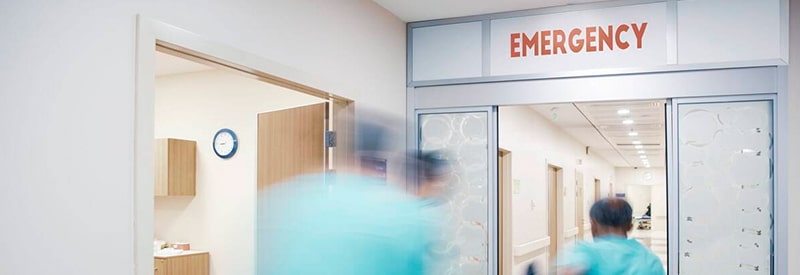
Emergency room in Cushing, OK
The skilled physicians at Hillcrest Hospital Cushing’s 24-hour emergency room (ER) provide lifesaving care when it matters most. Our doctors offer various emergency medical services and urgent care treatments for our patients in Cushing, Oklahoma and beyond. We provide stroke care, treatments for heart attack, and care for other emergency conditions like major head and bodily injuries, burns, broken bones, and more. No matter your needs, you can turn to our ER during life’s unexpected moments.
Emergency conditions we treat
Our ER department provides a wide range of treatments for the following emergency conditions:
- Burns, cuts and lacerations
- Fractures and broken bones
- Heart attack
- Major head and bodily injuries
- Severe abdominal pain
- Severe infections
- Severe respiratory illnesses and complications
- Stroke
Should you need care for another condition not listed here, our physicians will connect you with a medical department at our hospital that is best suited to your needs.
What to expect in our ER
When a patient arrives at our ER, they are immediately triaged for treatment. Triage is the process by which individuals are screened based on the severity of their condition. Our emergency team implements the triage process to streamline your care while minimizing wait times.
Please be prepared to provide pertinent information about your medical history, including any medications you are taking, any allergies you may have, and a summary of your past illnesses, injuries and surgeries. Having this information readily available greatly assists our medical team in making informed decisions regarding your care.
Our goal in the ER is to provide prompt, quality medical attention for our patients, with continued emphasis on improving processes for a faster, more efficient emergency room experience.
Individual wait times can vary widely in the ER, based on the number of beds available, the number of patients needing care and the severity of their conditions. Patients with the most serious and life-threatening conditions will be seen first.
If you are experiencing a medical emergency, please call 911 or visit the nearest emergency room.
Recognizing heart attack symptoms
Call 911 if you or someone else displays the following heart attack symptoms:
- Chest pain/discomfort
- Feeling lightheaded
- Nausea/vomiting
- Pain or discomfort in the jaw, neck, back, arm or shoulder
- Shortness of breath or difficulty breathing
- Unusual fatigue
Recognizing stroke symptoms
There are many symptoms of a stroke that patients should be aware of. One way to remember the most common symptoms is to BE FAST:
- B – Balance. Is the person suddenly having trouble with balance or coordination?
- E – Eyes. Is the patient experiencing sudden vision troubles? This includes blurred vision, double vision, or loss of sight in one or both eyes.
- F – Face drooping. Ask the person to smile. Is one side of their face numb or drooping?
- A – Arm weakness. Ask the person to raise both arms to the same level. Does one arm drift downward? Is one arm weak or numb?
- S – Speech difficulty. Ask the person to say a sentence. Are they struggling to speak normally?
- T – Time to call 911. If the person is experiencing ANY of these symptoms, call 911 immediately.
Call 911 if you or someone else is displaying stroke symptoms. Patients who arrive at the ER within three hours of initial stroke symptoms have less chance of disability three months after a stroke than those who received delayed care.

